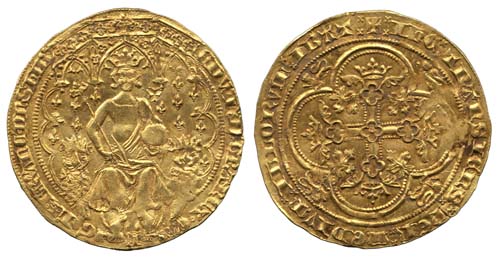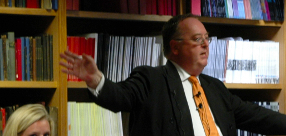
Auction: 6013 - Edward III (Double Leopard) The Hilary F Guard Collection of Manx Related Items Ancient, Islamic, English & Foreign Coi
Lot: 301
Edward III (1327-77), Double Leopard or Double Florin of 6s. 0d. (struck between January and July 1344), 6.986g., third coinage, first period, crowned king seated facing, holding sceptre and orb, flanked by two facing leopards or lions, the king under a Gothic three-arched portico, a tressure of three arches on each side, with lis on the cusps opposite the king´s elbows; lis scattered within the field, five on the left and seven on the right; edwr.d´.gra.rex.a./n/g l´.z.franc.dns.hib, annulet stops, rev. cross with quatrefoil and pellet at centre, quatrefoils and leaves at the terminals, a crown at the end of each terminal; all within a double quatrefoil with leaves at the cusps and leopards couchant in the quarters. +: ihc : transiens : per : medivm : illorvm : ibat : (N.1105; S.1476), very slightly creased, good very fine, a magnificent coin of the very highest importance and excessively rare - one of only three known specimens, and the only one in private hands Estimate £ 100,000-150,000 provenance:
Found by a detectorist in the south of England. The exact find spot is not being disclosed in order to protect the site.
Consigned by agreement with the landowner.
ISSUE
The coin was ordered through an indenture made with George Kirkyn and Lote Nicholyn of Florence, masters and workers (and others) dated 14th December 1343, and issued by Proclamation on the 27th January 1344. The Proclamation called for "One coin of two Leopards, the piece current for six shillings, which shall be the weight of two small florins of Florence of good weight..", and fractions thereof. Struck from "fine gold", the issue ceased in July 1344 and was effectively demonetised on 20th August 1344.
DENOMINATION
The Double Leopard was based on the gold Florin of Florence, issued from 1252 and containing 3.54g. of gold, which was frequently in use in England and which was imitated throughout Continental Europe (including later by Edward himself in Aquitaine). The Double Leopard was current for six shillings or 72 pence. Fractions consisting of a single Leopard and a Helm (half Leopard) were also issued.
DESIGN
The design described above appears to have been derived from the Masse d´or of Philip IV of France (1285-1314) and from Edward´s sixth great seal (in use from 1340-72). Evans states that "the so-called leopards of the Proclamation are in reality lions, leopard being the French heraldic term for a lion passant guardant, such as those in the royal arms of England". The elaborate design with its delicate Gothic tracery makes this issue one of the most ornate and attractive of any English coin.
REASON FOR ISSUE
English coinage had consisted of silver for several centuries, except for the short-lived gold Pennies of Henry III. Gold coinage was becoming increasingly common in Europe, and England was using Italian and French gold coins for large payments, especially overseas debts incurred as a result of the Hundred Years War, and as a store of wealth. The Florentine Florin became an international currency, and was copied in France: the Petit Royal d´or (1290) was of the same weight, and the Masse d´or (1296), from which the Double Leopard was derived, weighed two Florins. At the same time as Europe was experiencing a growing shortage of silver to meet the demands for coinage the gold supply increased, particularly from Hungary. These forces, together with perhaps an additional desire for political prestige, prompted the issue of a gold coinage.
REASON FOR FAILURE
Three reasons have been suggested for the short length of issue of the Double Leopard and its immediate replacement with the much more successful Noble. Firstly, the very high seigneurage (coinage) charges compared to the gold content. The seigneurage charges for the subsequent issues of Nobles was just over a third of those for the Double Leopard and its fractions. Secondly the over valued ratio of the gold content compared to silver. The Double Leopard´s ratio of c. 1 to 12 was reduced to c.1 to 11 for the Noble. Thirdly, the awkward denomination. Although based on a successful foreign coin, the denomination did not divide easily into the mark (13s. 4d) or pound (20s). The new Noble was exactly a half of a mark and a third of a pound.
THE THREE SPECIMENS
Only two other examples of this coin are known; they were discovered by schoolchildren together in the river Tyne in 1857. One was immediately retained by the British Museum. The second specimen was sold, firstly in the sale of the William Forster collection (Sotheby, 28th May 1868, lot 13, for £113 to Sir John Evans) and after passing through several hands was subsequently purchased by the British Museum. The present specimen was unearthed this year.
All three specimens are from different obverse and reverse dies. The main differences in the obverses are described here, but others will be noted on examination.
The first British Museum specimen is nearer in design to the specimen offered here, and is illustrated in Spink´s Standard Catalogue of British Coins, p. 162, no.1476. There are five lis on the left of the king and six lis on the right, a total of eleven. The king´s head is in a similar position to that on the second specimen. The cross at the top of the orb appears to be separate from the orb, and is near to the bottom of the arch on the right. The leopard or lion on the left is smaller and lower than that on the right. The letter N is between the king´s feet.
The second specimen is illustrated on plate XXV of Brooke and on page 11 of the introduction to vol. 1 of the Schneider collection. This specimen has twelve lis on either side of the king, twenty-four in total, including one under the king´s left arm. The leopards or lions are of equal size and height. The king´s head is smaller with more space between the top of his head and the arch. The line connecting the cross to the orb is faintly visible, and is some distance from the bottom of the arch. The letter G is between the king´s feet.
The specimen offered here has five lis on the left of the king, and seven on the right, a total of twelve, including one to the right of the leopard or lion´s cheek. The king´s head is larger and almost touches the top of the arch. The cross at the top of the orb again appears to be disconnected but is to the left of the point of the arch. The letter N is between the king´s feet.
The reverse dies are also different but differ only slightly, in spacing between the different elements of the design - the edge of the quadrilobe from the beaded border, the distance between the animals´ heads and the border, the shape of their tails, and other minor differences.
FRACTIONS
The single Leopard and Helm (half Leopard) are equally rare. Three Leopards and two Helms are held in institutions. A further Leopard was recently discovered and sold by Spink on 23 July 2003 (lot 379).
PREVIOUS ENGLISH GOLD COINS
Eight examples are known from Anglo-Saxon times of a gold Penny or Mancus, all of which are different. The earliest are from the reign of Offa of Mercia (757-96), providing three types, followed by a Mancus of Coenwulf of Mercia (796-821), sold by Spink in October 2004 and acquired by the British Museum in February this year. Later issues date from Wigmund, archbishop of York (c.837-54?), Edward the Elder (899-924), Aethelred II (978-1016), and Edward the Confessor (1042-66). The exact monetary status of these issues is unknown and remains a matter of dispute, as to whether they were intended for ceremonial purposes or as official coinages.
Henry III´s issue of a gold Penny in 1257, initially worth 20 silver pence and revalued in 1265 to 24 pence, was the first documented gold coinage, but was unsuccessful.
The Double Leopard offered here is the only example in private hands of the first large English gold coin, a direct precursor of the Noble and England´s splendid gold coinage. In historical importance the Double Leopard rivals the Coenwulf Mancus as probably the most important coin Spink has ever offered for sale at auction.
References
Brooke, G.C. English Coins from the seventh century to the present day (London, 1932, reprinted Spink, London, 1976)
Elias, D. The Anglo-Gallic Coins (Spink, London, 1984)
Evans, John, The First Gold Coins of England, Numismatic Chronicle, series III vol XX (1900)
The Herbert Schneider collection of English Gold Coins, vol. I, SCBI 47 (P. Woodhead, Spink, London, 1996), pp.6-12
Sold for
£400,000




